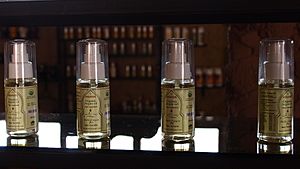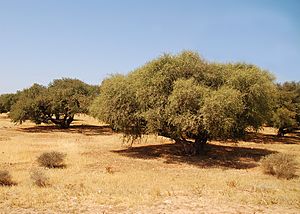Argan oil facts for kids
Quick facts for kids Argan, practices and know-how concerning the argan tree |
|
|---|---|
|
UNESCO Intangible Cultural Heritage
|
|

Argan paste making
|
|
| Country | Morocco |
| Reference | 955 |
| Inscription history | |
| Inscription | 2014 (14nd session) |
| List | Representative |
 |
|

Containers of argan oil
|
|
| Type | Plant oil |
|---|---|
| Place of origin | Morocco |
| Main ingredients | Fruit of the argan tree |
Argan oil is a special plant oil made from the seeds, or kernels, of the argan tree. This tree grows only in Morocco, a country in North Africa. In Morocco, people use argan oil for cooking, like dipping bread or drizzling it on couscous. It is also very popular in cosmetics, for skin and hair care.
Contents
What is Argan Oil Made Of?
Argan oil is mostly made of fats called triglycerides. These come from different types of fatty acids. It also has small amounts of other helpful things. These include tocopherols (which is vitamin E), phenols, carotenes, and squalene. These ingredients help protect the oil from going bad quickly.
How is Argan Oil Used?
Cooking with Argan Oil
In Morocco, argan oil is a common part of meals. People use it to dip bread in for breakfast. They also drizzle it over salads or dishes like couscous. A special thick paste called Amlu is also made with argan oil. It's like peanut butter and is used as a bread dip. Amlu is made by grinding roasted almonds with argan oil and then mixing them with honey.
Argan Oil in Beauty Products
Since the early 2000s, argan oil has become very popular in cosmetics. You can find it in many beauty and hair care products. By 2020, it was a key ingredient in face creams, lip glosses, shampoos, moisturizers, and soaps.
How Argan Oil is Made
The argan fruit has one to three kernels inside. These kernels are rich in oil. To get the oil, workers first dry the argan fruit in the sun. Then, they remove the soft, fleshy part of the fruit. This fleshy part is often used to feed animals.
Traditionally, in some parts of Morocco, goats would eat the argan fruit. The kernels would then be collected after the goats had digested the fruit. Today, the peels are usually removed by hand.
For cooking oil, the argan kernels are gently roasted. After they cool down, workers grind and press them. This process squeezes out the pure argan oil. The oil is then poured into containers. The leftover solid part, called press cake, is full of protein and is often used as animal feed.
Argan Oil Production and Growth
After argan oil became popular in the US in 2003, the demand for it grew a lot. Production has increased steadily since then. In 2012, the Moroccan government planned to increase production significantly.
To make sure the oil is pure, the Moroccan government started checking argan oil shipments before they are exported. This helps prevent the oil from being mixed with cheaper oils like sunflower oil.
By 2020, argan oil production had grown even more. This was partly because studies suggested it had health benefits. Almost all argan oil comes from Morocco.
The area where argan trees are grown is also getting bigger. It has expanded beyond the traditional growing areas.
Making argan oil by hand is a lot of work. It takes about 40 kilograms (about 88 pounds) of dried argan fruit to make just one liter of oil! Because of this, mechanical ways of extracting the oil have started. This can make the oil cheaper to produce. However, this can affect the small local groups, called cooperatives, where Berber women traditionally do most of the work by hand.
To help these small cooperatives, big companies like L'Oréal have promised to buy their argan oil from them. They want to support fair trade practices.
Why Argan Trees and Oil are Important
Protecting the Environment
The argan tree is very important for the environment in Morocco. It provides food and shelter for animals. Its deep roots help stop the desert from spreading. The shade from argan trees also helps other plants grow. The leaves and fruit provide food for animals.
Argan trees also help keep the soil stable and prevent it from washing away. They provide shade for grassy areas and help refill underground water sources.
Making argan oil has helped protect argan trees from being cut down. People have also started planting more argan trees. For example, in 2009, over 4,300 argan plants were planted in one area.
Groups like the Network of Associations of the Argan Biosphere Reserve (RARBA) work to ensure that argan trees are used in a way that protects them for the future. They have been involved in projects to fight desertification and help local communities.
Helping Communities and Women
Producing argan oil has always been important for the people living in the argan-growing region. Today, it supports about 2.2 million people.
Many women's cooperatives make a lot of the argan oil today. These cooperatives help women earn money. Many women use this income to pay for their own education or their children's education. This work also gives them more independence in a society that has traditionally been dominated by men. It has helped many women learn more about their rights.
The success of these argan cooperatives has encouraged other groups to use a similar model for their products. Many organizations, both in Morocco and internationally, have supported the creation of these cooperatives.
While the work is hard and long, there are efforts to ensure women in these cooperatives receive fair pay. Experts are working with the Moroccan government to make sure companies pay their workers the recommended minimum wage.
See also
 In Spanish: Aceite de argán para niños
In Spanish: Aceite de argán para niños




